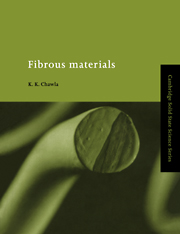Book contents
- Frontmatter
- Contents
- Preface
- Acknowledgments
- Chapter 1 Introduction
- Chapter 2 Fibers and fiber products
- Chapter 3 Natural polymeric fibers
- Chapter 4 Synthetic polymeric fibers
- Chapter 5 Metallic fibers
- Chapter 6 Ceramic fibers
- Chapter 7 Glass fibers
- Chapter 8 Carbon fibers
- Chapter 9 Experimental determination of fiber properties
- Chapter 10 Statistical treatment of fiber strength
- References
- Suggested further reading
- Appendix A Some important units and conversion factors
- Author index
- Subject index
Chapter 9 - Experimental determination of fiber properties
Published online by Cambridge University Press: 13 October 2009
- Frontmatter
- Contents
- Preface
- Acknowledgments
- Chapter 1 Introduction
- Chapter 2 Fibers and fiber products
- Chapter 3 Natural polymeric fibers
- Chapter 4 Synthetic polymeric fibers
- Chapter 5 Metallic fibers
- Chapter 6 Ceramic fibers
- Chapter 7 Glass fibers
- Chapter 8 Carbon fibers
- Chapter 9 Experimental determination of fiber properties
- Chapter 10 Statistical treatment of fiber strength
- References
- Suggested further reading
- Appendix A Some important units and conversion factors
- Author index
- Subject index
Summary
Experimental determination of the properties of any material is very important. This is particularly true in the case of fibrous materials because generally insufficient data are available for them. Fibers have one very long dimension and the other two extremely small. This makes determination of their properties, physical and mechanical, far from trivial. In particular, determination of their transverse properties, i.e. in the direction of the fiber diameter, can be difficult. In this chapter we describe experimental techniques to determine some physical and mechanical properties of fibers.
Physical properties
Many simple physical attributes of fibers can be quite important. We describe some of these attributes and the methods used to measure them.
Weight per unit length. This is also known as the yield and can be measured very simply by weighing a known length of fiber and expressing the result in grams per meter. This parameter is useful in comparing the yield of the final fiber from the precursor fiber, say carbon fiber from the polyacrylonitrile (PAN) precursor fiber.
Fiber diameter. This a very important parameter in characterizing a fiber. One can make a direct measurement of fiber diameter by means of an optical or scanning electron microscope. There is an ASTM standard (D 578) for this purpose.
The main problem with direct measurement is that fiber diameter may not be uniform along the length.
- Type
- Chapter
- Information
- Fibrous Materials , pp. 234 - 253Publisher: Cambridge University PressPrint publication year: 1998



